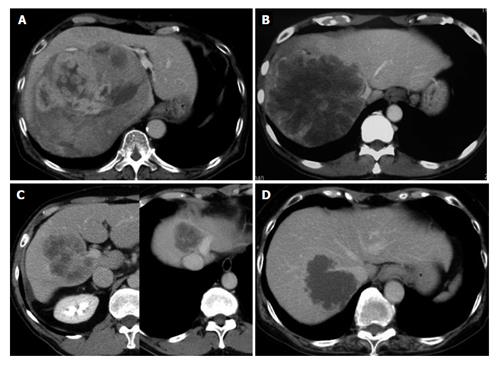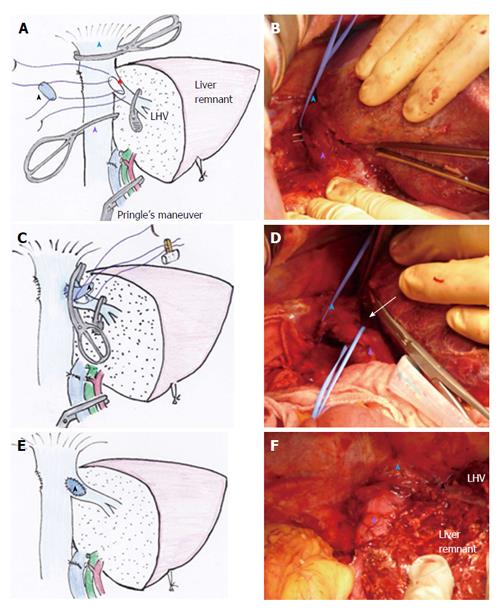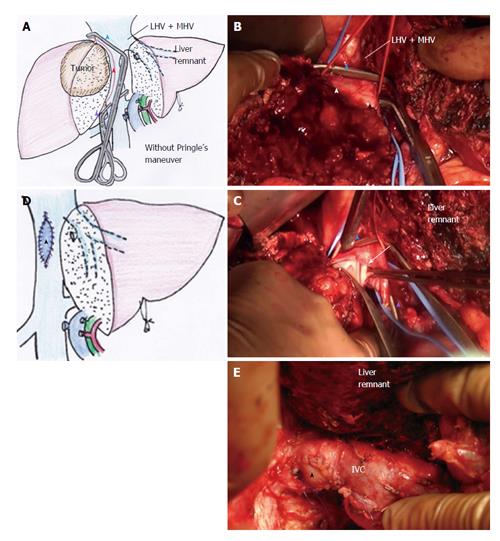Copyright
©The Author(s) 2016.
World J Hepatol. Mar 18, 2016; 8(8): 411-420
Published online Mar 18, 2016. doi: 10.4254/wjh.v8.i8.411
Published online Mar 18, 2016. doi: 10.4254/wjh.v8.i8.411
Figure 1 Abdominal computed tomography scan images of cases 1-4.
A: Case 1: Lumen of the IVC compressed by a huge right liver tumor with expansive growth; B: Case 2: A large right liver tumor involving the right aspect of the IVC and the confluence of middle and left hepatic veins; C: Case 3: Two tumors were present, a right liver tumor involving the right portal vein and the portal vein bifurcation, and another tumor occupying the cranial part of segments 4 and 8 and involving the left aspect of the trunk of the middle and left hepatic veins; D: Case 4: A tumor involving the right dorsal aspect of the IVC and its confluence of the right hepatic vein. IVC: Inferior vena cava.
Figure 2 Retrocaval liver lifting maneuver, performed in case 2.
A (illustration) and B (intraoperative image): The retrocaval space (arrow) was dissected broadly from the right lateral view toward the inner aspect of Spiegel’s lobe (black arrowhead), after which the supra- and infrahepatic IVC were taped to prepare cross-clamping for THVE (blue arrowhead and purple arrowhead); C (illustration) and D (intraoperative image): The index and middle fingers of the surgeon’s left hand were placed into the dissected retrocaval space, and the IVC was compressed ventrally to control bleeding around the IVC during deep parenchymal transection, after which the thumb finger of the surgeon’s left hand was used to spread the transection plane of the liver (C, which also shows the tumor status); D: Hepatic parenchymal transection is completed, except for the IVC involved site, before applying THVE; E (illustration) and F (intraoperative image): The liver specimen was excised along with the involved IVC and LHV wall (red arrowheads), and the backflow bleeding from the cut orifice of IVC was controlled by pinching the IVC using the surgeon’s left hand from its placement in the retrocaval space; F shows the view after reconstruction of IVC and LHV. See Figure 1B for tumor status. IVC: Inferior vena cava; LHV: Left hepatic vein; THVE: Total hepatic vascular exclusion.
Figure 3 Switching the cross-clamp, performed in case 3.
A (illustration) and B (intraoperative image): The right liver and involved right wall of the LHV and a part of the IVC wall had been resected en-bloc under standard THVE (red star indicates the orifice of resected IVC and LHV), before which the suprahepatic IVC was taped (blue arrowhead, blue tape), and the caudal cross-clamp was placed just under the confluence of LHV to the retrocaval space that had been already dissected (B). The defect of the confluence of the IVC and LHV was to be reconstructed by using an IMV patch graft (black arrowhead); C (illustration) and D (intraoperative image): After suturing the IMV patch graft to the IVC part of the defect, the IVC cross-clamps were removed and the clamp was switched to the confluence of the LHV to restore the systemic circulation via the IVC. The space for switching the clamp was spread by the caudal blue tape (white arrow in D); E (illustration) and F (intraoperative image): The view after reconstruction is shown. See Figure 1C for tumor status. IMV: Inferior mesenteric vein; IVC: Inferior vena cava; LHV: Left hepatic vein; THVE: Total hepatic vascular exclusion.
Figure 4 Oblique cranial cross-clamping, performed in case 4.
A (illustration) and B (intraoperative image): The trunk of LHV + MHV was free from tumor involvement, while the right aspect of the IVC was involved extensively (red arrowhead). After completion of hepatic parenchymal transection, the cranial IVC cross-clamp (blue arrowhead) was applied obliquely between the tumor-involved IVC and the trunk of LHV + MHV preserving outflow of the LHV + MHV trunk, which was possible because the retrocaval space had been dissected sufficiently. Then, the involved IVC wall (white arrowhead in B) and the liver was resected en-bloc under modified THVE; C (intraoperative image): The involved IVC wall was cut away with scissors (arrow) between the oblique cranial (blue arrowhead) and caudal (purple arrowhead) cross-clamps; D (illustration) and E (intraoperative image): The large cut orifice of IVC was reconstructed with IMV patch graft (black arrowhead). See Figure 1D for tumor status. IMV: Inferior mesenteric vein; IVC: Inferior vena cava; LHV: Left hepatic vein; THVE: Total hepatic vascular exclusion.
- Citation: Ko S, Kirihataya Y, Matsumoto Y, Takagi T, Matsusaka M, Mukogawa T, Ishikawa H, Watanabe A. Retrocaval liver lifting maneuver and modifications of total hepatic vascular exclusion for liver tumor resection. World J Hepatol 2016; 8(8): 411-420
- URL: https://www.wjgnet.com/1948-5182/full/v8/i8/411.htm
- DOI: https://dx.doi.org/10.4254/wjh.v8.i8.411












